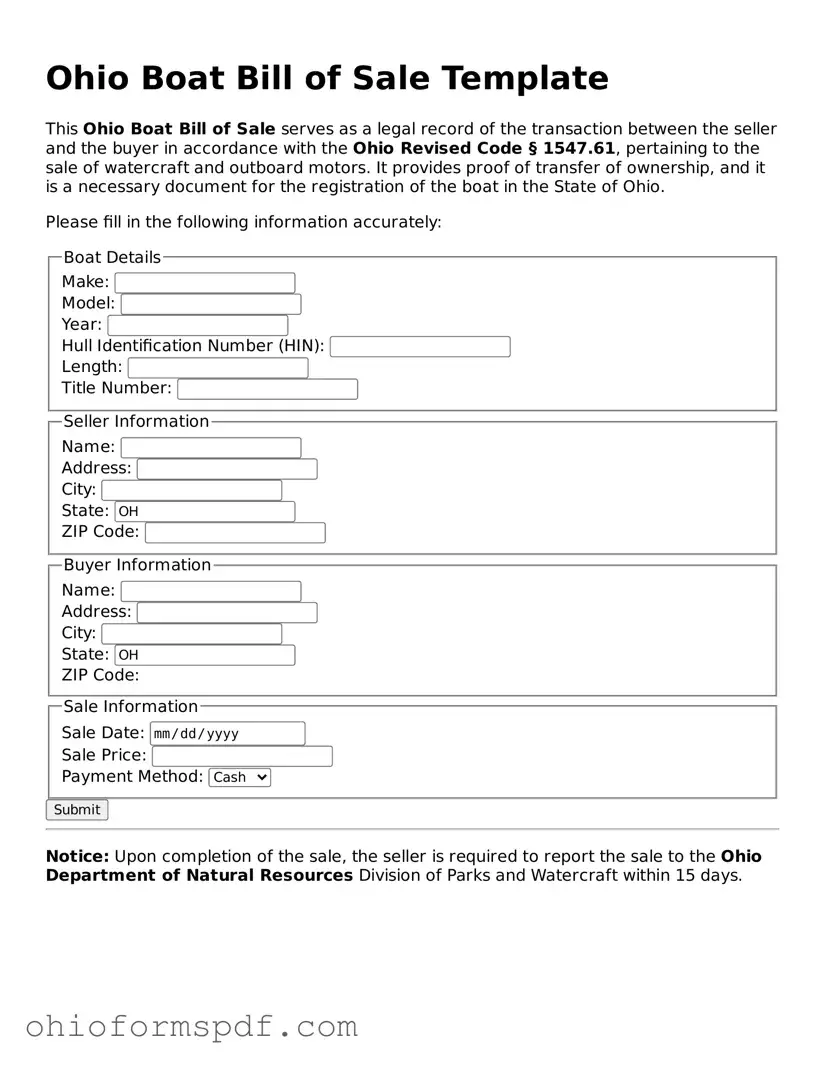What is an Ohio Boat Bill of Sale?
An Ohio Boat Bill of Sale is a legal document that records the sale and transfer of ownership of a boat from a seller to a buyer in the state of Ohio. It serves as a proof of purchase and documents the specifics of the transaction, including details about the boat, the sale price, and the parties involved.
Why do I need a Boat Bill of Sale in Ohio?
In Ohio, a Boat Bill of Sale is necessary for several reasons. It is required for the registration of the boat under the new owner’s name. It also protects both the buyer and the seller by providing a record of the transaction, detailing the condition and the agreed-upon price of the boat, which can be helpful in case of future disputes or for tax purposes.
What information should be included in a Boat Bill of Sale?
A comprehensive Ohio Boat Bill of Sale should include: the full names and addresses of both the buyer and the seller, the date of the sale, a detailed description of the boat (including make, model, year, and hull identification number), the sale price, warranty information, if any, and the signatures of both parties involved in the transaction.
Is it legally required to notarize a Boat Bill of Sale in Ohio?
No, it is not a legal requirement to notarize a Boat Bill of Sale in Ohio. However, getting the document notarized can add an extra layer of legal protection and authenticity to the transaction. It confirms that both parties willingly signed the document in the presence of a notary public.
Can I create a Boat Bill of Sale myself, or do I need a lawyer?
You can create a Boat Bill of Sale yourself without the need for a lawyer. There are templates available that you can use as a guide. However, ensuring that the document is thorough and includes all necessary information is important. If the boat sale is complex or involves significant amounts, consulting with a lawyer to review the document may be beneficial.
What happens if I lose my Boat Bill of Sale?
If you lose your Boat Bill of Sale, it's recommended to contact the other party involved in the transaction and request a copy. If that's not possible, recreating the document with as much accurate information as possible and having it signed again by both parties might be necessary. Keeping digital copies can prevent such situations.
Do I need a Boat Bill of Sale for a boat gift or donation in Ohio?
Yes, even if a boat is being gifted or donated, a Boat Bill of Sale is advisable. It should state that the boat was given as a gift or donation and indicate a nominal or zero amount as the sale price. This document is important for registration and tax purposes.
How does a Boat Bill of Sale protect the buyer?
A Boat Bill of Sale protects the buyer by providing proof of ownership, ensuring that the legal title of the boat is transferred from the seller to the buyer. It documents the condition and specifics of the boat at the time of sale, safeguarding the buyer against potential claims of prior damage or encumbrances on the boat.
